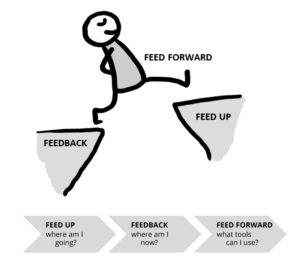Focus on the learning process through formative evaluation
In education, tests are conducted and assignments are given. But what do the results of those tests and assignments actually say about a student? Does he know, after such a test or assignment, how he can improve? Do teachers know how to guide their students?
When the learning process of children is viewed formatively, it provides much more information about the learning process. Using formative evaluation, you look at the learning goal: you look at where a student is in relation to this learning goal and you determine which steps need to be taken, to help the student move towards that learning goal.
When you look at the learning process in this way, it is much easier to offer students the tools with which they can develop further.
 In this book we provide guidelines, such as strategies and working methods, that support this formative process.
In this book we provide guidelines, such as strategies and working methods, that support this formative process.
The very essence of formative evaluation is to get insight into the learning process of your students, with the aim of supporting them in taking feasible steps towards the intended learning goals.
Feed up, feedback and feed forward
With formative assessment, the student and the teacher gain insight into how the student is learning. To support the progress of this learning process, you provide feed up, feedback and feed forward in three successive steps:
- Feed up: Where does the student need to accomplish? What is the learning goal?
- Feedback: Where does the student currently stand, in relation to that goal?
- Feed forward: What action is needed so that the student can progress?
Based on the information from step 2 (the feedback), the teacher and student can determine which steps are needed (feed forward) to achieve the learning objective of step 1 (feed up).
Example: The multiplication table of 6
You teach maths and want your students to know the multiplication table of 6 before the holidays start. How do you approach this in a formative way?
Feed up
The students in your group should know what you expect of them. So you tell them what the learning goal is: you want them to know the multiplication table of 6 before the holidays.
How are you going to test this? You tell your students that too.
For example: ”If you indicate that you know the multiplication table of 6, we will arrange a time where I will give you a number of random questions. For example: 8 x 6 = …, 3 x 6 = … You get a maximum of 10 seconds for each question, but I would prefer you to say the answer immediately.”
You also tell how you will practise the multiplication tables in class and why it is so important to know the multiplication tables. Illustrate that with examples. Show that the multiplication tables form the basis for many math questions, and that it will save a lot of time if you know the tables by heart.
Give examples that the children in your class will recognize. For example: ”You can count how many benches there are in the classroom, but you can do it faster by calculating it. There are 5 groups with 4 benches and 2 with 6 benches. That’s two multiplication table sums: (5 x 4) + (2 x 6).”
Feedback
In class, you regularly check where students are, in relation to the learning goal (knowing the multiplication table of 6). Let students practise together – by having one student say the multiplication table of 6 out loud while the other checks, or by having students ask each other random questions. You walk around the class to see how things are going. Use different working methods. Some students learn more easily to the rhythms, so let them use that to their advantage.
Give students feedback. For example: “You already know all the answers, but you can still increase your pace”. Or: “You can already say the multiplication table of 6 well, but you don’t know the answer when asked at random yet”. Or: “I notice that you practise when I ask you to, but you do not practise on your own yet”.
Then you give the student suggestions for a next step (feed forward).
Self-assessment
It is important that students learn to assess for themselves whether they have mastered a learning goal. In this case: if and to what extent they master the multiplication table of 6. You can do this, for example, with a self-evaluation card, on which students can mark that they can already say a multiplication table in order, or criss-cross. In the column ‘the next step’ they can write what they will do to achieve this learning goal.
Feed forward
Feed forward is intended to help students further along. For example a situation where a student who does not yet know the multiplication table of 6, and you know that he does not practise at home. If that student exercises and is easily distracted, but loves computer games, then you could let the students’ parents know that the student is allowed to practise on a telephone with a fun and good practice app. Or let this student practice not alone but with a classmate, and so on.
Let the student think about what works best for him to learn. Reflection helps with the learning process.
Additional assignment
For those students that excel at a task, you can challenge them to come up with a game where classmates can practise the multiplication table of 6 outside the classroom. Or have them give examples when adults would use the multiplication table of 6.
